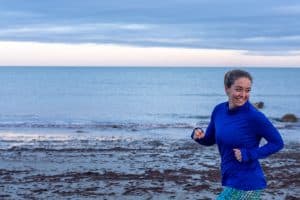By
Catherine Robertson Souter
July 5th, 2024

Beth Connolly, Psy.D., started her Hampton, NH-based practice “This is My Happy Pace: Therapeutic Running Services,” in 2019.
If "motion is lotion" for the body, what must it do for the mind? With evidence backing the theory that exercise provides a therapeutic boost for mental health, a small but growing movement in psychology has taken a next step by combining the two. The result is offering movement-based therapy sessions out on the road, beach, nature paths, or rail trails.
Beth Connolly, Psy.D., started her Hampton, NH-based practice "This is My Happy Pace: Therapeutic Running Services," in 2019, after working in traditional office-based therapy for a decade.
With 95% of her clientele taking advantage of the opportunity to move therapy outside, Connolly has seen record growth since its founding. She spoke with New England Psychologist’s Catherine Robertson-So...
Posted in
Interviews,
Subscribers |
Comments Off on NH psychologist combines running, therapy

